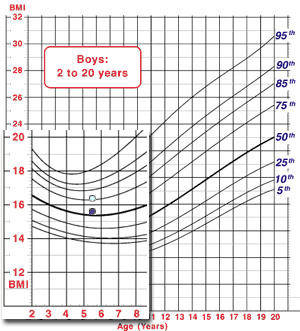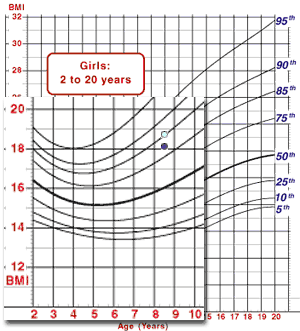Accuracy of Measurements
How accurately can you screen for overweight or obesity in children by looking?
Measurements must be obtained and recorded accurately if they are to be used as an effective screening tool. Stature and weight should be measured by following recommended protocols:
Stature: http://depts.washington.edu/growth/module5/text/page7b.htm
Weight: http://depts.washington.edu/growth/module5/text/page6b.htm
The following examples illustrate the importance of accurate measurements and show that inaccurate measurements can result in an inaccurate growth assessment.
Examples:
Example 1: Sanjay
Sanjay is a 5.5-year-old boy, weighing 41.5 pounds with a height of 43.0 inches. His calculated BMI is 15.8. When plotted on the BMI-for-age chart for boys, his BMI falls just above the 50th percentile (shown by the purple dot).

Inaccurate Measurement
If his height were measured or recorded inaccurately at 42.25 inches (3/4-inch below his actual height of 43.0 inches), his BMI-for-age would be 16.3 and fall on the 75th percentile (shown by the aqua dot). In this example, the measurement error did not cause a change in classification because growth remained within the normal range, but you see what could happen.
Example 2: Maria
Maria is an 8.5-year-old girl with a weight of 58.0 pounds and a height of 47.5 inches. Her BMI is 18.1. When plotted on the BMI-for-age chart for girls, her BMI falls between the 75th and 85th percentiles (shown by the purple dot).

Inaccurate Measurement
If her weight were measured or recorded inaccurately at 60.0 pounds (2.0 pounds above her actual weight of 58.0 pounds), her BMI-for-age would be 18.7 and fall on the 85th percentile (shown by the aqua dot), and thus, Maria would be considered overweight. An error in weight could occur if scales are not adequately maintained, standard protocol is not followed for weighing, or a recording error is made.
- Page last reviewed: May 9, 2014
- Page last updated: May 9, 2014
- Content source:


 ShareCompartir
ShareCompartir